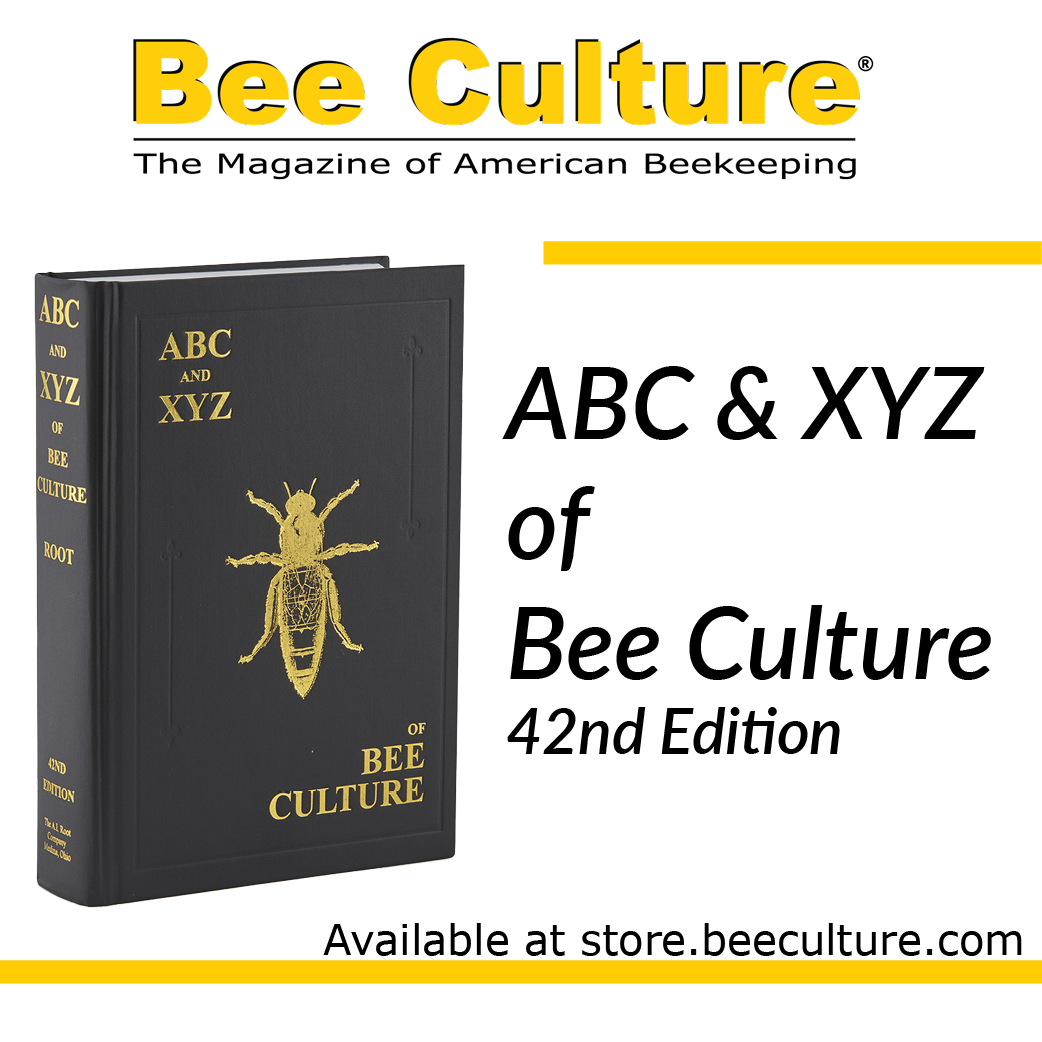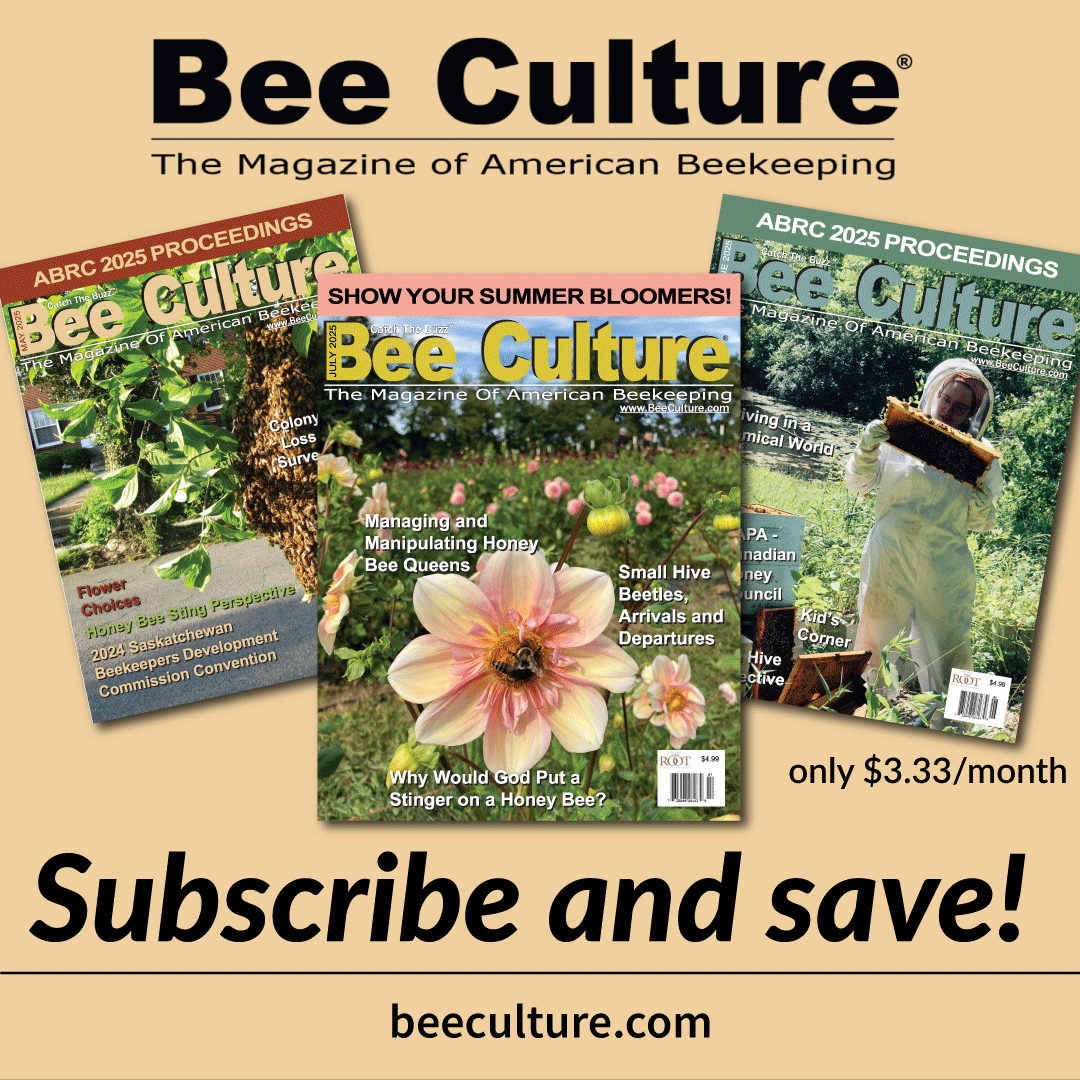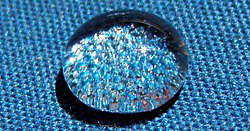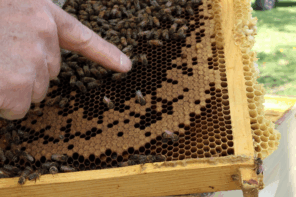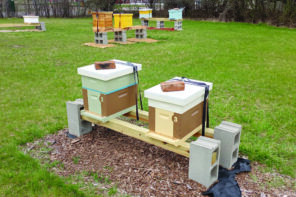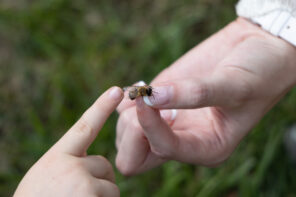Click Here if you listened. We’d love to know what you think. There is even a spot for feedback!
Read along below!
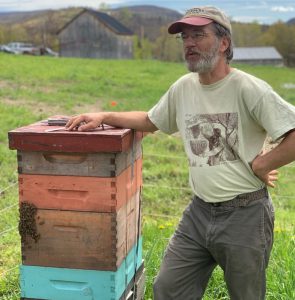
PFAS and Bees
Forever Chemicals: An Endless Threat
to Honey Bees (and their keepers)
By: Ross Conrad
It has never been so hard to keep bees alive as it is today. Many of us even measure our success in beekeeping by the percentage of hives that survive from year to year. In September of 2023, I wrote in these pages about the threat of forever chemicals and their potential for negatively impacting honey bee colonies. Since then additional research suggests that this family of chemicals is not only a huge hazard to human health and well-being, but is currently a global threat to honey bee health that, by all indications, will extend far into the future.
What are forever chemicals?
Per-and polyfluoroalkyl substances (PFAS) are a family of organofluorine compounds that contain carbon-fluorine bonds attached in a chain. This structure makes PFAS extremely stable and resistant to degradation, hence the “forever chemical” nickname. Thousands of these chemicals are used in industry and commerce, and in general, the more fluorine atoms they contain the more toxic they are. Since these compounds have unique characteristics they are found in a huge number of consumer products.
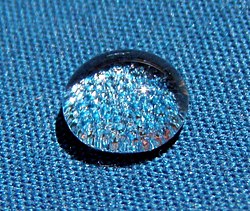
Forever chemicals (PFAS) are found in a wide-range of consumer products including fluorine-containing durable water repellents that make fabrics water resistant.
Because they are so pervasive and persistent, forever chemicals easily make their way into the environment where many PFAS, such as PFOS and PFOA, pose significant health and environmental concerns. These compounds move through soil, collect in water and are recognized by the U.S. EPA as a contaminant of emerging concern in surface waters. While they are regularly found in rain water, ground water, agricultural runoff waters, wastewater and aquatic environments such as rivers, streams, lakes, and ponds, the ultimate destination for all these toxins is the world’s oceans. This means that water collected by bees as a dietary mineral source, to help liquefy crystallize honey, and to help keep the hive cool during hot weather can be a significant source of PFAS exposure.
Pesticides: A major source of PFAS contamination
Another significant pathway for contamination are PFAS that are included in pesticides that are applied to our landscape at the rate of thousands of tons annually. Often PFAS are an active ingredient in a pesticide formulation and listed on the Material Safety Data Sheet (MSDS). Now please note that I am not a fan of Artificial Intelligence (AI), which like Bitcoin, requires obscene amounts of electrical energy to run acres of computer servers and therefore increases our reliance on fossil fuels at a time when we need to be weaning ourselves off coal, oil and natural (aka fracked) gas as fast as possible. However, when I Googled “pesticides with PFAS as active ingredients” the new AI Overview feature provided automatically by Google offered the following sample of pesticides:
Flutolanil: A fungicide for crops and ornamentals
Fluvalinate: An insecticide for crops and ornamentals (also approved for controlling Varroa mites in beehives)
Fomesafen and Fomesafen-sodium: A herbicide for crops
Hexaflumuron: A termiticide
When the words “pesticides with the highest concentration of PFAS as active ingredients” is Googled, the results are:
Spiromesifen: A 2022 study that looked at PFOS contamination in pesticides found that this insecticide contained PFOS at a level of 19,200,000 parts per trillion (ppt), which is much higher than the EPA’s Maximum Contaminant Level Goal of zero ppt (Lasee et al., 2022)
Imidacloprid: A neonicotinoid found to contain 13,300,000 ppt PFOS
Malathion: This insecticide which has been in use since 1956, contained 17,800,000 ppt of PFOS
The forever chemicals in pesticides are not only from active ingredients. A review of the MSDS for most pesticides indicates that the data sheets do not include all the ingredients of the pesticide formulation in the Composition/Information on Ingredients section of the MSDS. Sometimes the active ingredients listed compose less than half of the pesticide formulation. These hidden additional ingredients, also known as adjuvants, are allowed to be kept secret under the guise of being proprietary information. A business’s proprietary information is information that a company develops and markets as confidential and labels a trade secret that is not available to the public or government without restrictions such as non-disclosure agreements.
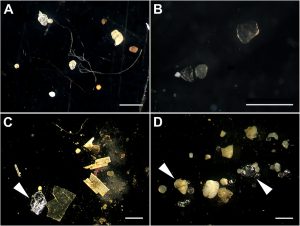
Microplastics in sediments from four rivers in Germany. Note the diverse shapes indicated by white arrowheads. (The white bars represent 1 mm for scale.) Source: Martin Wagner et al. – Wagner et al.: Microplastics in freshwater ecosystems: what we know and what we need to know. In: Environmental Sciences Europe. 26, Wikipedia.
When “inert” does NOT mean “chemically inactive”
In the case of pesticides, the missing ingredients from the MSDS are often labeled as “inert” despite the fact that some of these so-called inert ingredients are just as toxic, or even more toxic, than the pesticide’s active ingredients. (Nagy et al., 2020)
Adjuvants are added to a pesticide formulation to enhance the performance, improve the stability and typically increase the toxicity of a pesticides’ active ingredients. Uses of inert ingredients include spreaders, mixing agents, drift retardants, anti-foaming agents, wetting agents and dispersants that facilitate the spread of herbicides on plant leaves or increase the uptake by plants. Since the unique characteristics of forever chemicals often impart the above-mentioned attributes, many “inert” proprietary ingredients in use contain PFAS compounds. Unfortunately, this lack of transparency makes it difficult to accurately determine the level of PFAS found in commercial pesticides that we apply in our yards and to food crops, crops that often require commercial honey bee pollination services.
Can bees detect PFAS?
Recently scientists decided to test the ability for honey bees to detect the presence of forever chemicals and avoid these toxins when they are added to sugar syrup. Using a Y-maze, researchers studied the response of individual bees to PFOS-spiked sugar syrup at four different concentrations from slightly to highly concentrated. The bee’s activities, behavioral choices and drinking duration at both spiked and unspiked sugar syrup was recorded. It was only at the two highest concentrations that bees significantly avoided drinking the PFOS-spiked syrup, and then only when given a choice that included unspiked syrup. When the unspiked syrup was removed, the bees drank the spiked syrup at all the PFOS concentrations tested. This suggests that while bees may be able to detect, and wish to avoid, PFOS in their forage when present at high concentrations, they have not learned to avoid it when there are no other options. The findings confirm that bees will forage on PFOS-contaminated resources at concentrations immediately detrimental to colony health. Such exposure has the potential to threaten crop pollination services as well as human health via food chain transfer in PFOS-contaminated regions. (Sonter et al., 2024)
The plastic nightmare
Another pathway for PFAS contamination of bee hives is through plastic. It has been estimated that half of all plastic ever produced has been manufactured just in the past 20 years. Plastic containers like those used to package and store pesticides are sometimes fluorinated, a process that adds PFAS to the plastic. The post-mold fluorination of plastic containers has led to PFAS leaching into products stored in the treated containers.
Meanwhile plastic containers and consumer products do not go away but break down into smaller and smaller pieces eventually forming what are known as microplastics. While some microplastics contain PFAS, even PFAS-free microplastics can be harmful to bees. This is because microplastics accumulate in honey bee tissues such as the brain, midgut, trachea and hemolymph. This accumulation can lead to negative impacts on honey bee health, behavior, and colony dynamics. Additionally, microplastics have detrimental impacts on the honey bees’ immune system. This plastic pollution can also cause changes in the profile of the bee’s exoskeleton (cuticle), lead to a reduction in body weight and interfere with eating frequency, all of which reduces a colonies overall survival rate. (Bashir et al., 2024) Whether the impact of microplastic’s on bees is due to the presence of PFAS compounds, from the plastic itself or some combination still appears to be an open question.
In November 2024, the world’s nations assembled to negotiate a global plastics treaty at the fifth U.N. Intergovernmental Negotiating Committee (INC-5) meeting where they failed to reach an agreement. Over 100 nations supported capping plastic production so the world can finally start to get a handle on the problem of plastic pollution. Unfortunately a handful of major oil producing countries including the United States, Saudi Arabia, Iran, Kuwait, Russia and trade groups like the American Chemistry Council would only agree to downstream measures that target plastic waste. This is an approach critics say would be futile given that the plastics industry plans massive increases in plastic production. In 2023, the United States, China, India, Saudi Arabia and South Korea were the biggest producers of plastic.

The US Environmental Protection Agency (EPA) is quietly fast-tracking approval of new PFAS “forever chemicals” for use by the semiconductor industry despite the fact that the agency is publicly pushing for more scrutiny of new PFAS and other chemicals. Semiconductors are used in a huge number of digital products. Photo credit: David Carron at English Wikipedia.
Bioaccumulation
All this is really bad news for honey bees and other pollinators. Not only do they get direct exposure to forever chemicals as they visit plants that are treated with PFAS containing pesticides, the plants themselves take up PFAS from the soil and water and concentrate it in the plant and its tissues. This is known as bioaccumulation: a process where a chemical or substance builds up in an organism over time, becoming more concentrated in the organism than in the organism’s surrounding environment.
Forever chemicals bioaccumulate in fish and wildlife. They are also known to become concentrated in plants including flowering crops usually pollinated by commercial and solitary bees. (Navarro et al., 2017; Xu et al., 2022)
Is has been suggested that the bioaccumulation properties of certain plants could be used to clean up PFAS contamination and bioremediate soils. Unfortunately, as much as 45 percent of the total PFAS uptake in some plants has been found in the plant’s pollen. This does not bode well for the health of pollinators and can also lead to additional PFAS environmental contamination issues from wind-blown pollen. (Wright et al., 2024)
Previous research found that when forever chemicals accumulate in the bodies of honey bees it leads to a halting of brood development at the lowest ranges tested. Higher concentrations of PFAS increase honey bee mortality which in turn results in a reduction in the ability for colonies to maintain and defend their hive. (Sonter et al., 2021) On the other side of the equation, hive products like pollen, propolis, honey and beeswax may also become contaminated with PFAS. (Nowak & Nowak, 2021)
It is bad enough that honey bees and their keepers are struggling with loss of forage from development and changing land use patterns, increased pest and disease issues created by global economic trade, climate related disasters aggravated by the burning of fossil fuels, exposure to industrial and consumer pollutants and toxic pesticides; now we have the ongoing issue of forever chemicals to be concerned about as they build up in our environment. It’s at the point where our society is failing us in so many ways, that rather than feeling successful for keeping our hives alive, not throwing in the towel and giving up on beekeeping altogether is likely to be the true determination of beekeeping success in the future.
References:
Bashir, S., P. Ghosh, P. Lal (2024) Dancing with danger – how honey bees are getting affected in the web of microplastics – a review, NanoImpact, 35: 100522, ISSN 2452-0748 https://doi.org/10.1016/j.impact.2024.100522
Lasee, S., K. McDermett, N. Kumar, J. Guelfo, P. Payton, Z. Yang, T.A. Anderson (2022) Targeted analysis and total oxidizable precursor assay of several insecticides for PFAS, Journal of Hazardous Materials Letters, 3:100067
Nagy, K., R.C. Duca, S. Lovas, M. Creta, P.T.J. Scheepers, L. Godderis, B. Adam (2020) Systemic review of comparative studies assessing the toxicity of pesticide active ingredients and their product formulations, Environmental Research, 181;108926
Navarro, I., A. de la Torre, P. Sanz, M.A. Porcel, J. Pro, G. Carbonell, M.L. Martinez (2017)
Uptake of perfluoroalkyl substances and halogenated flame retardants by crop plants grown in biosolids-amended soils, Environmental Research, 152, pp. 199-206
Nowak, Adriana and Ireneusz Nowak (2021) Review of harmful chemical pollutants of environmental origin in honey and bee products, Critical Reviews in Food Science and Nutrition, pp 5094-5116 https://doi.org/10.1080/10408398.2021.2012752
Sonter, C.A., Rader R., Stevenson, G., Stavert, J., Wilson, S.C. (2021) Biological and behavioural responses of European honey bee (Apis mellifera) colonies to perfluorooctane sulfonate (PFOS) exposure, Integrated Environmental Assessment and Management, 17(2)
Sonter, C.A., M. Tighe, R. Radar, S.C. Wilson (2024) Can bees detect perfluorooctane sulfonate (PFOS)? Environmental Toxicology and Chemistry, 43(7):1638-1647
Wright, T., M. Crompton, D. Bishop, G. Currell, L. Suwal, B.D. Turner (2025) Phytoremediation evaluation of forever chemicals using hemp (Cannabis sativa L.): Pollen bioaccumulation and the risk to bees, Chemosphere, 370: 143859, ISSN 0045-6535, https://doi.org/10.1016/j.chemosphere.2024.143859
Xu, B., W. Qiu, J. Du, Z. Wan, J.L. Zhou, H. Chen, R. Liu, J.T. Magnuson, C. Zheng (2022) Translocation, bioaccumulation, and distribution of perfluoroalkyl and polyfluoroalkyl substances (PFASs) in plants, iScience, 25, Article 104061


